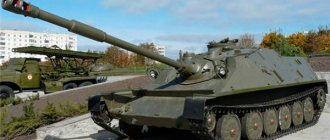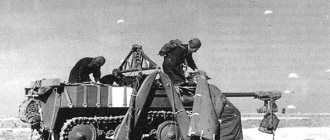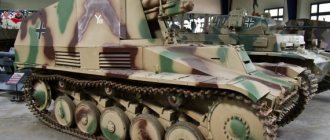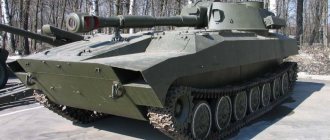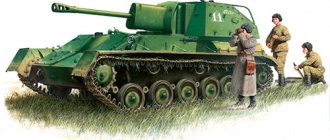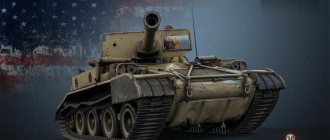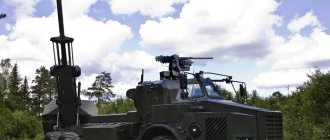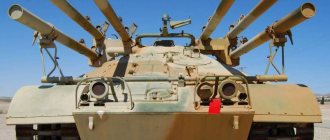Characteristics of the AK-176 shipborne installation
A country:USSR/RussiaType:Ship automatic installationDate of issue:1977Calculation:2 people (in manual mode 4 people)Caliber:76.2 mmLength:Barrel length 59 calibersWidth:No informationWeight:The weight of the projectile is 5.9 kg, the weight of the installation without ammunition and cooling systems is 10,450 kg.Rate of fire:30-120 rounds per minuteFiring distance:15.7 km horizontally, 7 km verticallyInitial projectile speed:980 m/sAmmunition:152 shots per barrel
“Soviet naval artillery mount AK-176. Characteristics, history of creation"
References
- “Russian Navy ships will receive promising 76-mm AK-176MA naval artillery systems.”
- ^ ab “A new high-precision gun mount for the Navy was tested in St. Petersburg.” Russian newspaper . March 3, 2022. Retrieved March 5, 2017.
- https://www.armstrade.org/includes/periodics/news/2019/0711/125053368/detail.shtml
- “Project 22800 Corvette Karakurt | Rosoboronexport catalogue". roe.ru.
_ Retrieved September 27, 2022.
The history of the creation of the AK-176 naval gun mount
The shipborne automatic artillery mount AK-176 was created according to technical specifications dated September 30, 1969. In 1971, the technical design of the installation, coded A-221, was proposed by the Burevestnik Central Research Institute under the leadership of chief designer G.P. Ryndyka.
The result of the work was a unique single-barrel artillery system, which still remains one of the fastest-firing in the world. Its entire ammunition load of 152 rounds can be shot in just two bursts of 75 rounds with a break of 30 seconds!
Field tests of the A-221 were completed by mid-July 1977 and by Order of the USSR Ministry of Defense No. 101 of June 22, 1979, the Ak-176-MR-123/176 complex was put into service. The A-221 installation received the AK-176 index, and its mass production was launched at the Gorky Machine-Building Plant.
The AK-176 can be controlled both locally and remotely.
Drawing of a naval artillery mount AK-176
H/PJ-26
76 mm gun H/PJ-26
713-M Institute (also known as Zhengzhou Electrical Engineering Research Institute) China Shipbuilding Industry Corporation (CSIC) of the People's Republic of China developed the Chinese version of the AK-176, with Mr. Chen Dingfeng (陈汀峰) as general designer. Design began in 2000 and was completed in 2003. The main difference between this H/PJ-26 and the AK-176 is that the Chinese variant uses a hidden turret design, while the turret structure uses more composite materials. Additionally, the number of ready rounds for the H/PJ-26 has been doubled to 150 rounds from the original 75 rounds for the AK-176.
Army and weapons
The "armor resistance"/"gun power" competition is slowly developing among infantry fighting vehicles
. Early versions of automatic cannons cannot meet the requirements, so more powerful guns are being developed. For example, the 20-mm Rheinmetall Rh 202 automatic cannon, using 20x139-mm ammunition, in connection with the announced trend, was replaced by the ATK M242 Bushmaster cannon of 25x137-mm caliber.
Currently, even 30mm caliber guns are not something special and they are quite standardized. Russian infantry fighting vehicles , were in service for many decades
were equipped with an automatic cannon for 30x165 mm ammunition, later the Mauser MK 30 and ATK Bushmaster II (was replaced by the MK44 in production for the US naval forces, installed on expeditionary combat vehicles), both used 30x 173 mm
ammunition
.
Only one event breaks this trend - the Soviet AK-630 (NN-30) gun developed in 1950 for the Navy. She used 30x210mm ammunition. In the 1980s in Yugoslavia, the Zastava M86 (single supply of cartridges) and M89 (double supply of cartridges) were adopted under a similar cartridge; they were equipped with Yugoslav infantry fighting vehicles
.
M2A2 Bradley with 25 mm M242 Bushmaster cannon
Looking through the chronology of events further, we can see a Japanese Type 89 MICV combat vehicle with a 35x228 mm Oerlikon KDE gun. Next, the Netherlands and Denmark chose the CV9035 for their infantry fighting vehicles.
Bushmaster III automatic cannon chambered for the same cartridge.
For several years, the Swedes were armed with the CV9040 infantry fighting vehicle
with a Bofors L70 cannon of 40x365R caliber.
This ammunition
was also used by the new
Korean infantry fighting vehicle
. In the late 1970s, Germany considered the idea of equipping the Marder infantry fighting vehicle with the new Bofors cannon chambered for 57x438R ammunition, but the idea did not materialize.
Marder infantry fighting vehicle with automatic 57-mm Bofors cannon (Courtesy Harry Zertner)
A few years later, the Italian company Otobreda and the Israeli IMI jointly developed the HVMS 60 (High Velocity Medium-Support) automatic 60mm cannon chambered for the new 60x410R ammunition. After some time, these two companies separated and continued to work on weapons separately. To date, similar guns, but probably with manual drives, are equipped with old tanks in Chile, the exporting company is IMI.
The most traditional and widely advertised today is the Russian AU-220 turret gun, which uses old cartridges from the S-60 automatic anti-aircraft gun of 57x347SR caliber. Initially, it was intended to re-equip the PT-76 light amphibious tank, but now the possibility of installation on Russian infantry fighting vehicles
.
PT-76 with 57 mm AU-220 cannon
60-mm OTO Melara gun on Dardo infantry fighting vehicle
Shells (caliber and gun): 20x139 (HS 820, US M139, GIAT 20M693, Rh 202), 25x137 (M242 Bushmaster), 30x165 (2A42, 2A72), 30x170 (Rarden), 30x 173 (Bushmaster II / MK44, Mauser MK30), 30x210B (Zastava M86/89), 35x228 (Oerlikon KDE, Bushmaster III)
Shells (caliber and gun): 35x228 (Oerlikon KDE, Bushmaster III), 40x364R (Bofors L/70, Bushmaster IV), 57x347SR (Russia AU-220M), 60x410R (IMI / OTO 60 mm)
In order to effectively combat enemy armored vehicles, many countries are developing spin-stabilized solid core sabot projectiles (APHC), spin-stabilized spin-stabilized sabot projectiles (APDS), and spin-stabilized finned core sabot projectiles (APFSDS). These ammunition are approximately considered as miniature copies of tank shells of the same name.
The illustration shows a 35mm APDS (sub-caliber detachable sabot) projectile and a 25mm APFSDS-T (BOPS tracer).
The cores of most BPS are made of tungsten alloys, although they are also available from depleted uranium (American 25 mm M919). The relatively low power of these projectiles is compensated by their significant penetrant effect.
One of the reasons for the increase in the caliber of guns is the enhanced armoring of infantry fighting vehicles
.
This fact was clearly visible during the war in Iraq. It is obvious that the weight of existing infantry fighting vehicles
is gradually increasing.
Thus, over the course of its history, the Bradley M2
increased in weight from 23 tons to 30 tons, the German
Warrior
- from 25 to 32 tons, the CV90 from 21 (prototype) to 35 tons, the German
Marder
from 27.5 tons to 37.5 tons, and the new German
Puma
car immediately weighs 43 tons!
BMP "Puma" with a 30-mm Mauser MK 30-2 gun
CV9035 infantry fighting vehicle with 35 mm Bushmaster III cannon
During combat, there is often a need to blow holes in buildings, and, more importantly, to detonate a high-explosive shell over enemy infantry. In this case, high-explosive ammunition (HEAB) or ABM (remote-detonated projectiles) is used.
The first in this field was a modified version of the Oerlikon cannon's remotely detonated shrapnel projectiles (AHEAD), which included 30- and 35-mm shells. However, in this case, the fragments were shot only forward and did not affect the soldiers behind. In solving this problem, the minimum effective caliber for the OFS was 30 mm, but still more interest in this direction is given to 35 and 40 mm ammunition. Thus, the designers intend to make a projectile for the future, with a reserve, because usually the ammunition is used for several decades.
Thus, Dutch research into the use of 30-mm BOPS led to the conclusion that this ammunition is ineffective against modern Russian BMP-3s, so the Dutch gave preference to the 35-mm caliber. However, in an effort to increase the caliber of the gun, designers are faced with a lot of obvious difficulties. For example, installing new weapons can be difficult due to the fact that the size of the turret and the diameter of its ring are predetermined. They cope with some difficulties quite gracefully. Thus, a 40-mm telescopic cartridge was developed for the modernized former 30-mm Bushmaster II gun. The ammunition has a core recessed deep into the cartridge case and is 173 mm in length (the same as the 30x173 mm caliber). To use it, you will need to slightly change the gun's automatic loader and its gun. Several years ago, General Dynamics Ordnance and Tactical Systems (GD-OTS) were selecting the optimal length of ammunition to replace the HE (164 mm) and APFSDS (218 mm) versions and, ultimately, settled on a single telescopic projectile with a length of 180 mm for both. Currently, projects of telescopic ammunition of 40 mm and 50 mm caliber have not gone beyond the scope of experiments, the development of 50 mm projectiles has been stopped, and 40 mm is progressing extremely slowly.
One of these slow-moving studies is the Western program, which, within the framework of Franco-British cooperation, includes the creation of a 40-mm telescopic weapon system (CTWS - Cased Telescoped Weapon System). The project is supervised by CTA International, an association of Nexter (formerly GIAT) and British Aerospace. The ammunition used is very short, its caliber is 40x255 mm. However, the armor penetration of such shells is comparable to the shells of a 40 mm Bofors cannon or a 50 mm gun (in all 3 cases a similar composition of the propellant charge is used).
40x255 mm telescopic shot, core and steel block pierced by it
The gun is designed in a special way: shots are fed from the side (as well as cartridges are removed) using a rotating drum. The drum is located on the axis of the trunnions, so it does not move when raising/lowering the implement. The mechanism has a low risk of power failures and is very compact. Competitors claim that the lateral supply of ammunition makes it difficult to stabilize the gun, note the low safety margin of the gun and point to the high cost of ammunition. But, in this case, the high cost is justified by the larger caliber and, therefore, the lower consumption of shots to destroy the enemy.
The illustration shows experimental ammunition (from left to right): 30x173, 40x180 telescopic HE and APFSDS, experimental high-performance round 35x228; 50x330mm telescopic APFSDS (+ sectional diagram); 40x255 CTWS + 30mm Rarden APDS for comparison.
The photo below shows the CTWS gun and its ammunition.
——————-
Discuss on the forum
Translation and illustrations of the site: https://www.quarry.nildram.co.uk/WLIP.htm
Notes[edit | edit code]
- ↑ 12345
Shirokorad, 2000, p. 1021. - ↑ 123
Shirokorad, 2000, p. 1022. - Field tests of the modernized AK-176MA naval artillery mount have been completed
- Shirokorad, 2000, p. 1030.
Users
Valid
- Russia
- Russian Navy
- Algeria
- Algerian National Navy
- Bangladesh
- Bangladesh Navy
- Bulgaria
- Bulgarian fleet
- China
- People's Liberation Army Navy
- Cameroon
- Cameroon Navy
- Egypt
- Egyptian fleet
- India
- Indian Navy
- Pakistan
- Pakistan Navy
- Romania
- Romanian Navy
- Vietnam
- Vietnam People's Navy
- Yemen
- Yemeni Navy
Past users
- Poland
- Polish Navy
- Soviet Union
- Soviet fleet
- Ukraine
- Ukrainian Navy
